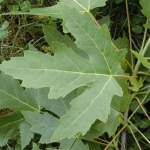

In North America, many indigenous tribes have traditionally used maple wood to make paddles and oars, and in building, basketry, and furniture-making. The popular maple syrup is produced mainly in Canada. For centuries, Native North Americans have cut into the trunks of sugar maples in the late winter to collect the sap. Today this is done on a commercial scale. If the trees are not over-bled and hence damaged, they can be tapped again the following year. But it takes 40 gallons (182 litres) of sap to make just 1 gallon (4.5 litres) of syrup. Pure maple syrup is precious because in contains balanced sugars, minerals such as potassium, calcium, magnesium and manganese, vitamins A, B2, B5 and B6, folic acid, niacin, biotin, and also proteins. But beware - some cheaper products might only contain a fifth of maple syrup in a mixture otherwise made up of corn syrup and various artificial additives, so always check the label before buying. |
|
The old Welsh tradition of carving love spoons utilizes sycamore, but apart from the rich tradition of being made into musical instruments (maple wood has qualities excellent for sound transmission), the European maples hardly ever left the farmyard. However, in North America it is a different story, particularly with the sugar maples. A tale among the Salteaux tribe relates how the fiery autumn leaves of the maples save the grandmother of Nanahboozhoo, the Creator, from malevolent spirits of darkness. Nanahboozhoo was so grateful, and also so taken with the maples' beauty, that he decided to live among them. One day, some tribespeople came and asked him how to collect maple sap and he showed them how to do so without harming the trees more than necessary. The maple features in myths and legends on many other Native North American tribes. In a story told by the Chippewa people about a hero called Mishosha, the maple was once an evil magician. However, Mishosha's courageous and skillfull deeds turned a most malevolent man into the most benevolent tree. The Iroquois legend of "The Hunting of the Great Bear" relates how four brothers were hunting Nyahgwaheh, an enormous bear. After a long and arduous chase, they finally struck him down a the top of a mountain. They made a fire, cooked the bear and ate. When they were replete they looked down and saw thousands of small sparkling lights beneath and around them. They were no longer on the mountain top, but up in the sky!. The bones of the great bear came back to life and started to run, and the four brothers grabbed their spears and followed him across the skies. And they still do - because the four brothers make up the constellation of the Great Bear. Every autumn, when they kill him, so the legend says, the bear's blood falls down from the heavens and paints the maple leaves scarlet. The Kiowa nation uses the wood of the box elder (A. negundo) to burn on the altar fire at the sacred peyote ceremony (peyote is an hallucinogenic cactus). |
|